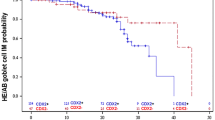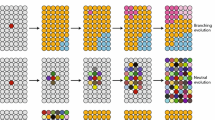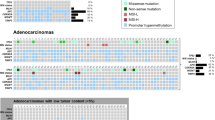Abstract
Barrett’s esophagus (BE) is an acquired condition in which the normal lining of the esophagus is replaced by intestinal metaplastic epithelium. BE can evolve to esophageal adenocarcinoma (EAC) through low-grade dysplasia (LGD) and high-grade dysplasia (HGD). The only generally accepted marker for increased risk of EAC is the presence of HGD, diagnosed on endoscopic biopsies. More specific markers for the prediction of EAC risk are needed. A tissue microarray was constructed comprising tissue samples from BE, LGD, HGD, and EAC. Marker expression was studied by immunohistochemistry using antibodies against CD44, DKK1, CDX2, COX2, SOX9, OCT1, E-cadherin, and β-catenin. Immunostaining was evaluated semi-quantitatively. CD44 expression decreased in HGD and EAC relative to BE and LGD. DKK1 expression increased in HGD and EAC relative to BE and LDG. CDX2 expression increased in HGD but decreased in EAC. COX2 expression decreased in EAC, and SOX9 expression increased only in the upper crypt epithelial cells in HGD. E-cadherin expression decreased in EAC. Nuclear β-catenin was not significantly different between BE, LGD, and HGD. Loss of CD44 and gain of DKK1 expression characterizes progression from BE and LGD to HGD and EAC, and their altered expression might indicate an increased risk for developing an EAC. This observation warrants inclusion of these immunohistochemically detectable markers in a study with a long patient follow-up.






Similar content being viewed by others
References
Flejou JF (2000) Barrett’s oesophagus: from metaplasia to dysplasia and cancer. Gut 54(Suppl 1):i6–i12
Koppert LB, Wijnhoven BP, van Dekken H et al (2005) The molecular biology of esophageal adenocarcinoma. J Surg Oncol 92:169–190
Playford RJ (2006) New British society of gastroenterology (BSG) guidelines for the diagnosis and management of Barrett’s oesophagus. Gut 55:442
el-Serag HB, Sonnenberg A (1998) Opposing time trends of peptic ulcer and reflux disease. Gut 43:327–333
Blot WJ, McLaughlin JK (1999) The changing epidemiology of esophageal cancer. Semin Oncol 26(5 Suppl 15):2–8
Farrow DC, Vaughan TL (1996) Determinants of survival following the diagnosis of esophageal adenocarcinoma (United States). Cancer Causes Control 7:322–327
Falk GW, Rice TW, Goldblum JR et al (1999) Jumbo biopsy forceps protocol still misses unsuspected cancer in Barrett’s esophagus with high-grade dysplasia. Gastrointest Endosc 49:170–176
Heitmiller RF, Redmond M, Hamilton SR (1996) Barrett’s esophagus with high-grade dysplasia. An indication for prophylactic esophagectomy. Ann Surg 224:66–71
Shaheen NJ, Crosby MA, Bozymski EM et al (2000) Is there publication bias in the reporting of cancer risk in Barrett’s esophagus? Gastroenterology 119:333–338
Flejou JF, Svrcek M (2007) Barrett’s oesophagus—a pathologist’s view. Histopathology 50:3–14
Morales CP, Souza RF, Spechler SJ (2002) Hallmarks of cancer progression in Barrett’s oesophagus. Lancet 360:1587–1589
Clement G, Braunschweig R, Pasquier N et al (2006) Alterations of the Wnt signaling pathway during the neoplastic progression of Barrett’s esophagus. Oncogene 25:3084–3092
Doucas H, Garcea G, Neal CP et al (2005) Changes in the Wnt signalling pathway in gastrointestinal cancers and their prognostic significance. Eur J Cancer 41:365–379
Shi XY, Bhagwandeen B, Leong AS (2008) p16, Cyclin D1, Ki-67, and AMACR as markers for dysplasia in Barrett esophagus. Appl Immunohistochem Mol Morphol 16:447–452
Shi XY, Bhagwandeen B, Leong AS (2008) CDX2 and villin are useful markers of intestinal metaplasia in the diagnosis of Barrett esophagus. Am J Clin Pathol 129:571–577
Nair KS, Naidoo R, Chetty R (2005) Expression of cell adhesion molecules in oesophageal carcinoma and its prognostic value. J Clin Pathol 58:343–351
Taketo MM (2006) Wnt signaling and gastrointestinal tumorigenesis in mouse models. Oncogene 25:7522–7530
Okamoto R, Watanabe M (2004) Molecular and clinical basis for the regeneration of human gastrointestinal epithelia. J Gastroenterol 39:1–6
Johnson ML, Rajamannan N (2006) Diseases of Wnt signaling. Rev Endocr Metab Disord 7:41–49
van Es JH, van Gijn ME, Riccio O et al (2005) Notch/gamma-secretase inhibition turns proliferative cells in intestinal crypts and adenomas into goblet cells. Nature 435:959–963
Almeida R, Almeida J, Shoshkes M et al (2005) OCT-1 is over-expressed in intestinal metaplasia and intestinal gastric carcinomas and binds to, but does not transactivate, CDX2 in gastric cells. J Pathol 207:396–401
Bian YS, Osterheld MC, Fontolliet C et al (2002) p16 inactivation by methylation of the CDKN2A promoter occurs early during neoplastic progression in Barrett’s esophagus. Gastroenterology 122:1113–1121
Brantjes H, Barker N, van Es J et al (2002) TCF: lady justice casting the final verdict on the outcome of Wnt signalling. Biol Chem 383:255–261
Yan P, Seelentag W, Bachmann A et al (2007) An agarose matrix facilitates sectioning of tissue microarray blocks. J Histochem Cytochem 55:21–24
Villanacci V, Rossi E, Zambelli C et al (2007) COX-2, CDX2, and CDC2 immunohistochemical assessment for dysplasia-carcinoma progression in Barrett’s esophagus. Dig Liver Dis 39:305–311
Bailey T, Biddlestone L, Shepherd N et al (1998) Altered cadherin and catenin complexes in the Barrett’s esophagus-dysplasia-adenocarcinoma sequence: correlation with disease progression and dedifferentiation. Am J Pathol 152:135–144
Pinto D, Clevers H (2005) Wnt, stem cells and cancer in the intestine. Biol Cell 97:185–196
Clevers H, Batlle E (2006) EphB/EphrinB receptors and Wnt signaling in colorectal cancer. Cancer Res 66:2–5
Gregorieff A, Pinto D, Begthel H et al (2005) Expression pattern of Wnt signaling components in the adult intestine. Gastroenterology 129:626–638
Mutoh H, Sakamoto H, Hayakawa H et al (2006) The intestine-specific homeobox gene Cdx2 induces expression of the basic helix-loop-helix transcription factor Math1. Differentiation 74:313–321
Liu T, Zhang X, So CK et al (2007) Regulation of Cdx2 expression by promoter methylation, and effects of Cdx2 transfection on morphology and gene expression of human esophageal epithelial cells. Carcinogenesis 28:488–496
Greenawalt DM, Duong C, Smyth GK et al (2007) Gene expression profiling of esophageal cancer: comparative analysis of Barrett’s esophagus, adenocarcinoma, and squamous cell carcinoma. Int J Cancer 120:1914–1921
Ngan CY, Yamamoto H, Seshimo I et al (1996) Expression of CD44H and CD44v3 in normal oesophagus, Barrett mucosa and oesophageal carcinoma. J Clin Pathol 49:489–492
Lagorce-Pages C, Paraf F et al (1998) Expression of CD44 in premalignant and malignant Barrett’s oesophagus. Histopathology 32:7–14
Menges M, Goebel R, Pueschel W et al (2002) Expression of CD44v5 and -v6 in Barrett’s carcinoma is not increased compared to that in nondysplastic Barrett’s mucosa. Exp Mol Pathol 72:207–212
Niehrs C (2006) Function and biological roles of the Dickkopf family of Wnt modulators. Oncogene 25:7469–7481
Sato H, Suzuki H, Toyota M et al (2007) Frequent epigenetic inactivation of DICKKOPF family genes in human gastrointestinal tumors. Carcinogenesis 28:2459–2466
Aguilera O, Fraga MF, Ballestar E et al (2006) Epigenetic inactivation of the Wnt antagonist DICKKOPF-1 (DKK-1) gene in human colorectal cancer. Oncogene 25:4116–4121
Ali I, Rafiee P, Hogan WJ et al (2006) Dickkopf homologs in squamous mucosa of esophagitis patients are overexpressed compared with Barrett’s patients and healthy controls. Am J Gastroenterol 101:1437–1448
Van Baal JW, Bozikas A, Pronk R et al (2008) Cytokeratin and CDX-2 expression in Barrett’s esophagus. Scand J Gastroenterol 43:132–140
Wegner M (1999) From head to toes: the multiple facets of Sox proteins. Nucleic Acids Res 27:1409–1420
Blache P, van de Wetering M, Duluc I et al (2004) SOX9 is an intestine crypt transcription factor, is regulated by the Wnt pathway, and represses the CDX2 and MUC2 genes. J Cell Biol 166:37–47
Ferguson HR, Wild CP, Anderson LA et al (2008) Cyclooxygenase-2 and inducible nitric oxide synthase gene polymorphisms and risk of reflux esophagitis, Barrett’s esophagus, and esophageal adenocarcinoma. Cancer Epidemiol Biomarkers Prev 17:727–731
Feith M, Stein HJ, Mueller J et al (2004) Malignant degeneration of Barrett’s esophagus: the role of the Ki-67 proliferation fraction, expression of E-cadherin and p53. Dis Esophagus 17:322–327
Wijnhoven BP, Nollet F, De Both NJ et al (2000) Genetic alterations involving exon 3 of the beta-catenin gene do not play a role in adenocarcinomas of the esophagus. Int J Cancer 86:533–537
Williams LJ, Guernsey DL, Casson AG (2006) Biomarkers in the molecular pathogenesis of esophageal (Barrett) adenocarcinoma. Curr Oncol 13:33–43
Conflict of interest
We declare that we have no conflict of interest.
Author information
Authors and Affiliations
Corresponding author
Rights and permissions
About this article
Cite this article
Darlavoix, T., Seelentag, W., Yan, P. et al. Altered expression of CD44 and DKK1 in the progression of Barrett’s esophagus to esophageal adenocarcinoma. Virchows Arch 454, 629–637 (2009). https://doi.org/10.1007/s00428-009-0769-z
Received:
Revised:
Accepted:
Published:
Issue Date:
DOI: https://doi.org/10.1007/s00428-009-0769-z




